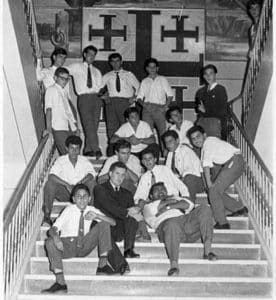[vc_row][vc_column width=”1/2″][vc_single_image image=”175119″ img_size=”full” onclick=”custom_link” link=”https://cyprus-mail.com/schools-guide/”][/vc_column][vc_column width=”1/2″][/vc_column][/vc_row][vc_row][vc_column width=”2/3″][vc_single_image image=”232250″ img_size=”full” add_caption=”yes”][vc_custom_heading text=”Private schools: part of island life for over 300 years” font_container=”tag:h2|font_size:24|text_align:left|color:%23ffffff” use_theme_fonts=”yes” css=”.vc_custom_1550743458956{padding-top: 5px !important;padding-bottom: 5px !important;padding-left: 10px !important;background-color: #2d2d2d !important;}”][vc_column_text]By Annette Chrysostomou
When considering which private secondary school is best for their child with all the facilities that are now on offer, it is a world away from how the sector started out in Cyprus. When the first private school which survives today was opened in 1646, the island was under Ottoman occupation.

Students of the Terra Santa school
Terra Santa, in Nicosia, has survived for 373 years. No other school operating today even comes close to being around for so long. The school later worked under British occupation before becoming a primary and secondary school.
The British occupation brought with it the need for a different kind of school, one with English as the main language of instruction. The British colonial establishment wanted a source of government clerks for employment who were capable of speaking English, Greek and Turkish. A school was started by Canon Newham who originally came to Cyprus in 1900 to teach English to elementary schoolmasters and clerks of the land registry. Just three months after he arrived, he started a new school, with just 13 boys, in Nicosia which became the English School.
Initially an all-boys school with boarding facilities, it became co-educational in 1962 when it merged with the English School for Girls, thus becoming the first co-educational school in Cyprus.
But it was quickly joined by other schools. The American Academy in Larnaca was founded in 1908 by two missionaries of the Reformed Presbyterian Church of North America, again just for boys. A department for girls opened in 1916. The initial experiment was short-lived and the girls’ department closed in 1919 but re-opened ten years later.
The Second World War caused disruption to both these schools, with the American Academy temporarily transferring to Lefkara and the English School to Kyrenia’s Castelli hotel because of fear of bombing in Nicosia, where it stayed between 1941 and 1943.
St Mary’s, in Limassol, also started operating under British rule, in 1921. It was administered by the Franciscan Missionary Sisters of the Sacred Heart, the majority of whom belong to the Maronite community.
The following year, the American Academy in Nicosia opened its doors. Founded by the same people who opened the American Academy in Larnaca for boys, it was established in response to local demand for an English language school for girls, and was named the American Academy for Girls.
Perhaps surprisingly, one school opened during WWII, the Junior School in Nicosia, which was established in 1944 by the British Council and remained under its direction until 1948, when it became a non-profit company.
The first English speaking school to open after the colonial days were over was the Grammar School in Nicosia. It started operating in 1963, moving with its boarding school to privately owned premises on a hill near Nicosia airport in 1966. During the Turkish invasion of 1974 the school was bombed and consequently occupied by the Turks.
The invasion also caused another school still operating today to move location. Foley’s, now in Limassol, opened in 1970 in Famagusta but was forced to leave in 1974. The 1970s and 1980s, in general, saw a lot of activity in the private school sector, with more schools opening up, including the Falcon School in Nicosia and the Heritage School in Limassol.
While the majority of these schools are English speaking, that is not the case for all private schools on the island. The French school Arthur Rimbaud opened in Nicosia in 1987 and was transformed in 2012 from a purely French school into the French-Cypriot School.
Since 1983, at least in Limassol, students have had the opportunity to attend a Lebanese school and various Russian schools, catering to the tens of thousands of Russians who live there.
In the capital, the demographics are different and a number of private Greek secondary schools have come into existence.[/vc_column_text][/vc_column][vc_column width=”1/3″][vc_btn title=”Back to Schools Guide” shape=”square” color=”inverse” size=”lg” align=”center” button_block=”true” link=”url:http%3A%2F%2Fcyprus-mail.com%2Fschools-guide%2F|||”][mp_ads_system ads_system_select=”176653″][mp_ads_system ads_system_select=”176658″][vc_custom_heading text=”Latest News” font_container=”tag:h2|font_size:24|text_align:left|color:%23ffffff” use_theme_fonts=”yes” css=”.vc_custom_1520498454660{padding-top: 5px !important;padding-bottom: 5px !important;padding-left: 10px !important;background-color: #2d2d2d !important;}”][mp_block_12 text_layout=”text-layout-5″ category_id=”45137″ post_text_chars=”300″ post_paging=”header_paging”][/vc_column][/vc_row]
